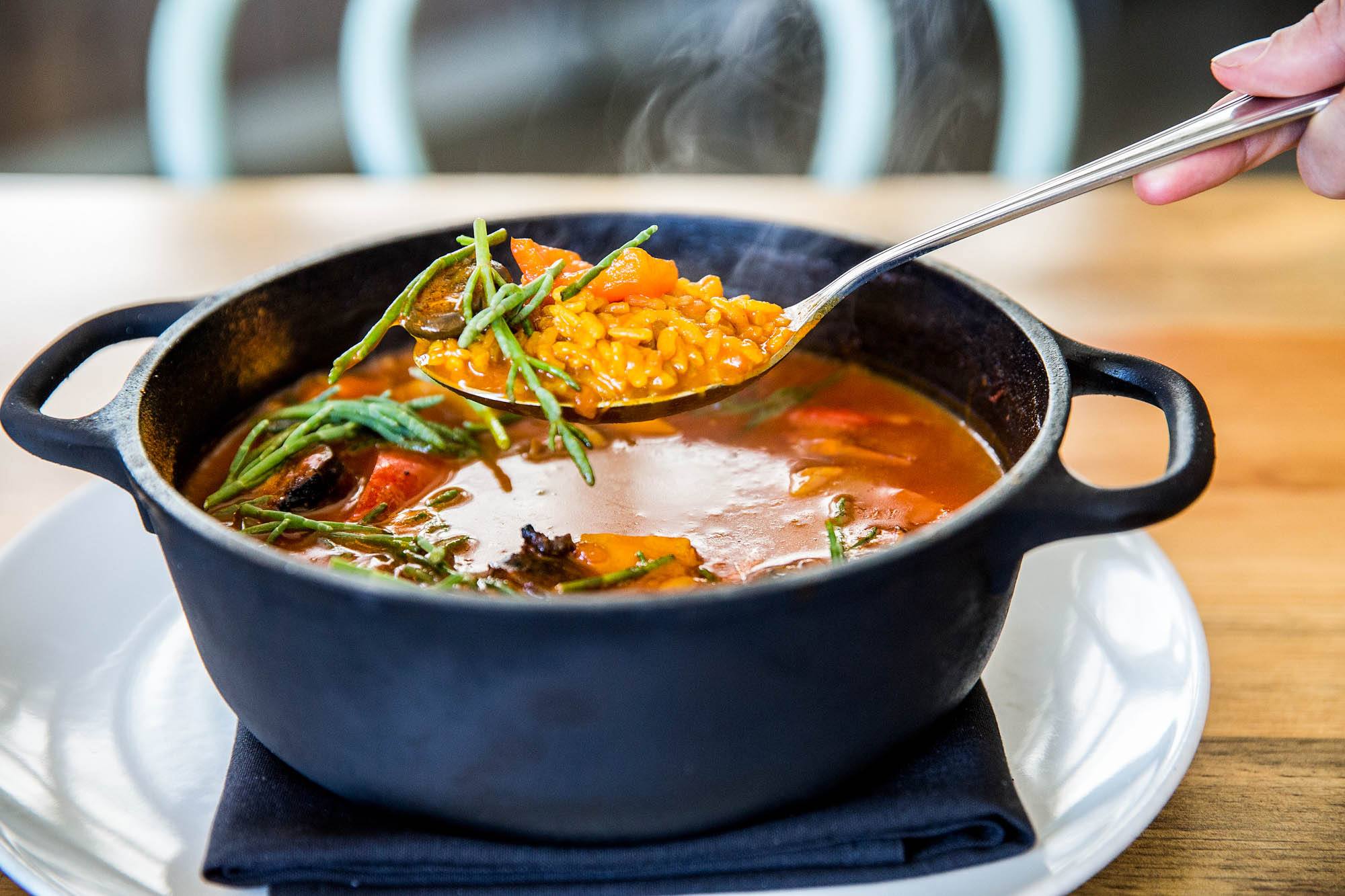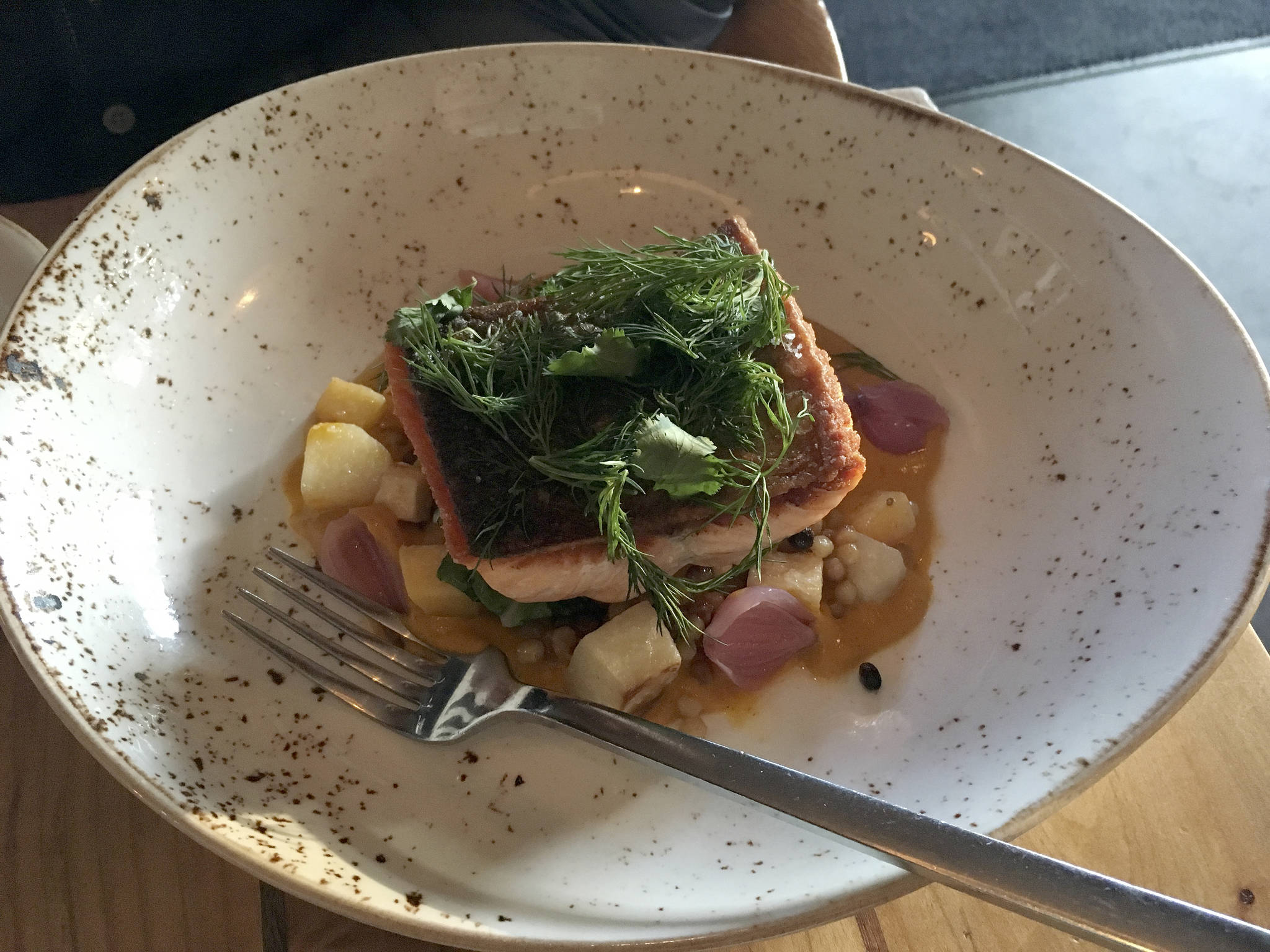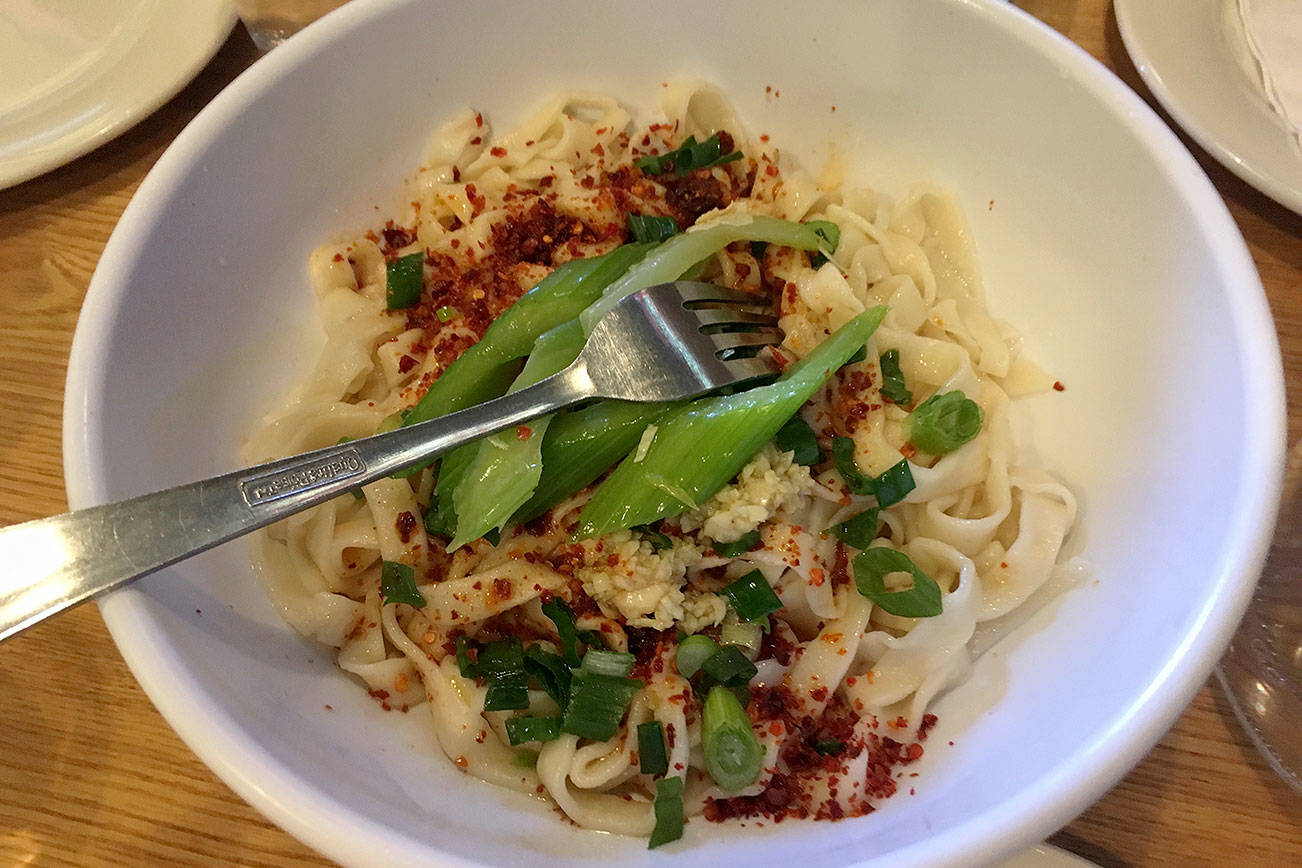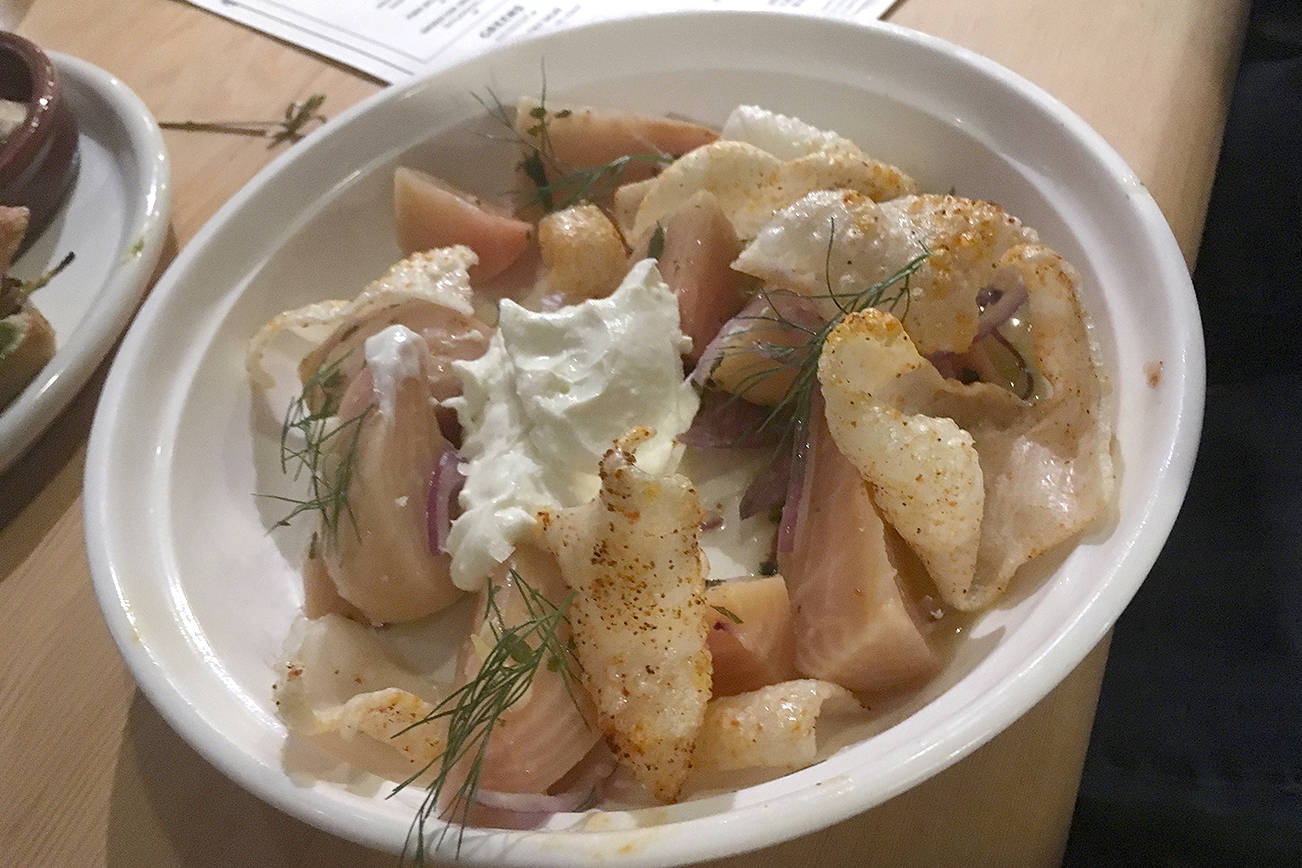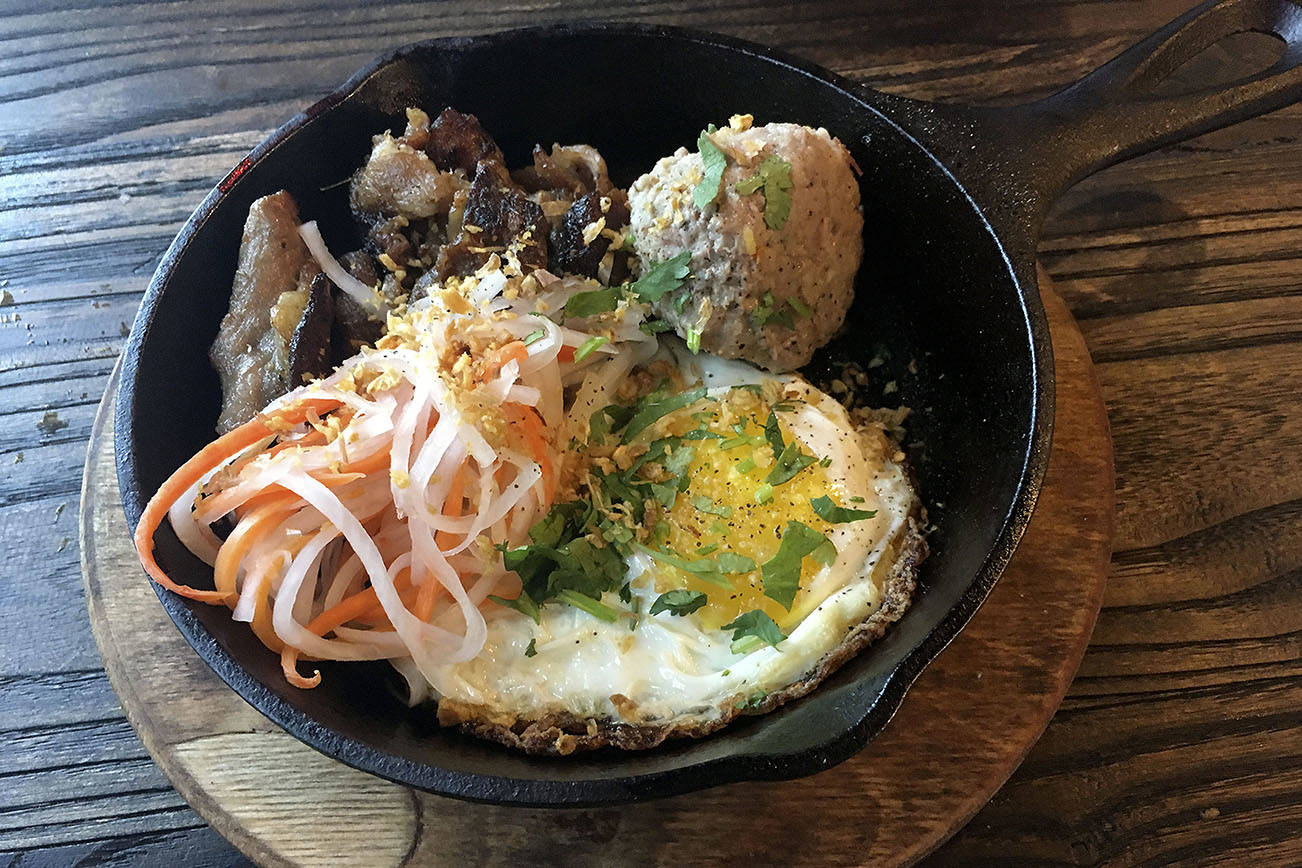There are good meals, even great meals. And then there are meals that are experiences, the ones that transcend the usual adjectives and stay with you long after you’ve swallowed the last bite. I felt that way when I dined at The Willows Inn on Lummi Island two years ago, and that same wonder and delight struck again last weekend at the recently opened Tarsan i Jane (4012 Leary Way N.W., 557-7059). There I was treated to a menu devised by Perfecte Rocher, formerly of the famed Picasso in Las Vegas and Smoke.Oil.Salt in LA. The Spanish-born chef has created an evolving seven- or nine-course tasting menu full of surprises—literally, since you don’t know what you’re getting until you’re there, but also in that he captures and combines flavors and uses ingredients in novel, nuanced ways.
A server told me that the restaurant resists the “Spanish” moniker, though Tarsan i Jane, which has taken up residence in the former Tray Kitchen space in Frelard, gives some of its dishes Catalan names. The restaurant’s website deems it “modern Valencian cuisine influenced by the Pacific Northwest.” And while these dishes border on the absurd in their ambition and description, they are anything but when they hit the palate.
Our seven-course meal ($87 per person) began with an amuse-bouche (so eight courses, really) of what look like two miniature chocolate cakes or decadent truffles resting atop fresh evergreen leaves. In fact, it’s botifarra: rich housemade blood sausage topped with a homemade barbecue sauce and a bright-green dab of tart yuzu. The last time I had blood sausage was at a Mets game in Queens, but this dish has none of the iron-like taste that accompanied that ballpark fare; instead, it’s deep and smoky, with the sauce’s sweetness and the yuzu’s citrus balancing out any overly earthy aftertaste. A barely perceptible hint of chili lingers in the back of the throat. They had my attention and I was eager for the next round.
It didn’t disappoint. The clotxines, served in a tiny bowl like a soup, is dubbed “mussels in three textures.” One is steamed and resting in a creamy mussel pâté, which floats in an escabeche sauce with mussels and mint oil, the acid of the escabeche lightly reminding the pâté to temper its opulence. It looks like colors before an artist mixes them together, all vibrant greens and orange and fleshy pink that, with the swirl of your spoon, meld dramatically into one another.
Next came tomaco del terreno: heirloom tomatoes in varying textures. I worried that we were on the precipice of culinary shtick, given the similarity in description to the previous dish, but I was captivated by the way it lives up to its conceit. By manipulating tomato in myriad ways—gorgeous, sensual chunks of heirlooms that expertly straddle the line between ripe and overripe; a spicy tomato sauce; a refreshing tomato water; a tomato foam that melts on the tongue—the chef manages to evoke the essence of that perfect, often unattainable bite of an in-season, just-out-of-the-garden summer tomato. And as with so many dishes, he takes it a step further, adding pieces of dried tuna loin for texture and a smoky note (like jerky), plus other homages to summer such as avocado purée and basil broth. Za’atar brings an element of mystery and another dimension of taste. At this point, I was confident I was in good hands, and the feeling continued through the pastenaga (carrot three ways), which transforms the humble vegetable into a purée, a guacamole, and a confit, intensified by black garlic, grated idiazabel cheese (a mix of cow and sheep cheese similar to a manchego, but slightly stronger), and salty shards of crisped kale.
My favorite dish, and the one that reminded me most of my meal at The Willows Inn, was one simple piece of wild Coho salmon, here house-smoked for 18 minutes to deliver a texture that’s almost sashimi-like and painted with a spicy glaze. Served over a salt-cod pâté that brings a stronger fish flavor than the salmon, it’s buoyed by an assertive broth of housemade red-wine vinegar and herbaceous tarragon oil. To that is added jewels of citrus “caviar,” the tart interior of a southeast Asian finger lime, as well as a few pieces of fried, salty salmon skin. The play of soft and strong, salt and sour, smoked and fried are profound. Nothing feels superfluous, despite so many ingredients—and the dish truly showcases chef Rocher’s imagination.
The next course of curried Beluga lentils and spinach—a kind of stew, really—with Spanish goat cheese comes with an egg on top, poached in its shell to give the yolk and the white a similar consistency. The egg is incorporated in the warm broth, which is flavored with natural truffle oil. Though this truffle oil is subtler than the more common variety that uses chemical compounds, it still overpowers the dish a bit, and the proportion of spinach to lentils is unbalanced in favor of the former. This is perhaps the only dish that doesn’t strike a delicate balance. It certainly looks pretty, though, its plate adorned with greenery and colorful autumn leaves.
By the time the sixth course arrived, I was quite full and, unfortunately, it too was a type of stew: a cassoletta d’arros negra of chickpeas, “bomba” rice, and locally foraged chanterelles and lobster mushrooms in a squid-ink and red-prawn broth with piquillo pepper and horseradish aioli. The flavor of the broth was notable, not nearly as briny as I’d expected but still strong, and the more docile mushrooms go astray. Still, I liked how it was served in a rustic black pot with two bowls; it’s the one course shared by you and your dining partner before the arrival of dessert, which comes in two distinctive, lidded vessels. One, white and peanut-shaped, contains a heavier rice pudding with butterscotch ice cream. The other, a gold walnut, holds a lighter treat of Saskatoon berries with caramelized walnut, house ice cream, and a wisp of citrus cava foam.
Though the meal can be paired with wine for an extra cost, more intriguing is the menu of gin and tonics, all made with local gins. I loved the Taronja, in which Old Tom counter gin is sweetened and spiced with vanilla, curry, and clove, a large, circular slice of orange orbiting the glass and a piece of clove left to permeate the cocktail. Every sip is a small applause of flavor, mirroring the meal’s quiet complexity.
My only complaints with Tarsan i Jane has more to do with the service and the setting. After being seated, we waited quite some time for our server to take our drink order. When drinks finally arrived, she jubilantly asked what we wanted to eat that night; my dining partner and I looked at each other confused since we thought it was a set tasting menu, and we’d been given no menus to challenge that assumption. When we warily replied “Well, we didn’t get any menus,” she asked if we were familiar with their tasting-menu concept. “Um, yes … ” She then proceeded to explain that we didn’t have a choice, but rather we’d be given a surprise pageant of dishes—which left us wondering why she’d asked what we wanted to eat in the first place. It made us feel stupid, and as a rule of thumb, diners who are embarking on this kind of adventurous dinner don’t like to feel talked down to. In fairness to her, it didn’t seem to be an act of snobbery, but an amateur mistake. It was an awkward beginning to an uneven evening; multiple servers brought out various courses throughout the night, and some were better-versed in explaining the minutiae of each dish than others, though all are exceedingly polite and brimming with bonhomie.
But what bothered me most was the lack of physical comfort and the lackluster environment. Little has been changed since the space’s incarnation as Tray Kitchen. A new restaurant shouldn’t remind you of the one that was there previously, yet the spacious, industrial room is still quite sparse, with virtually no decor. Plus, when indulging in such a sumptuous, special experience, I want a chair that befits the occasion—namely one that’s not hard and minimalist. Part of what makes The Willows Inn so magical is the way the food is complemented by the grace of the dining room and the magnificent views of the Sound and the sunset. I don’t expect Tarsan i Jane to conjure a waterfront location, but I at least hope for sensory details that accent the meal. For starters, dim the lights a bit. When you’re there for two hours, it’s a shame to feel slightly uncomfortable and anxious between courses, particularly when they dazzle as brightly as these.
food@seattleweekly.com
CORRECTION An earlier version of this review incorrectly stated that all of the menu items were written in Spanish. The story has been corrected.
